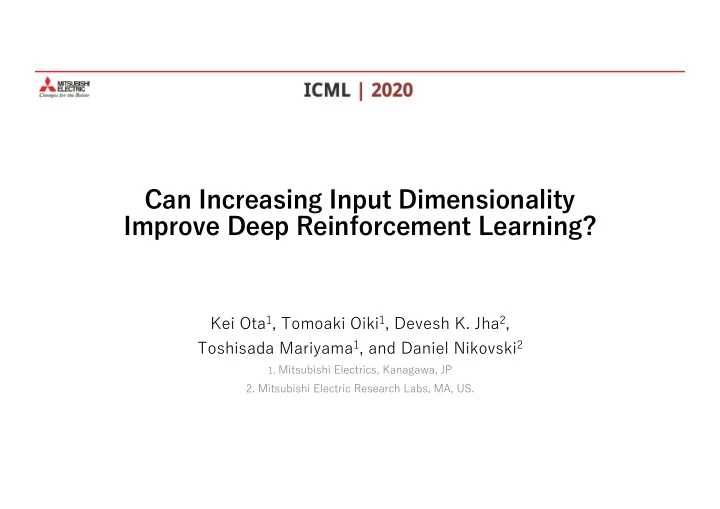

Can Increasing Input Dimensionality Improve Deep Reinforcement Learning? Kei Ota 1 , Tomoaki Oiki 1 , Devesh K. Jha 2 , Toshisada Mariyama 1 , and Daniel Nikovski 2 1. Mitsubishi Electrics, Kanagawa, JP 2. Mitsubishi Electric Research Labs, MA, US.
Introduction • Deep RL algorithms have achieved impressive success ü Can solve complex tasks X Learning representations requires a large amount of data [Akkaya, 2019] https://www.youtube.com/watch?v=rQIShnTz1kU
Introduction • Deep RL algorithms have achieved impressive success ü Can solve complex tasks X Learning representations requires a large amount of data • State Representation Learning (SRL) – Learned features are in low dimension, evolve through time, and are influenced by actions of an agent – The lower the dimensionality, the faster and better RL algorithms will learn Feature Policy Policy " # $ # " # $ # ! ! Extractor % & ' SRL + RL Standard RL
Introduction • Deep RL algorithms have achieved impressive success ü Can solve complex tasks X Learning representations requires a large amount of data • State Representation Learning (SRL) – Learned features are in low dimension, evolve through time, and are influenced by actions of an agent – The lower the dimensionality, the faster and better RL algorithms will learn Feature Policy Policy " # $ # " # $ # ! ! Extractor % & ' SRL + RL Standard RL Can Increasing Input Dimensionality Improve Deep RL?
OFENet: Online Feature Extractor Network • OFENet – Train feature extractor network & " and & ",% that produces high-dimensional representation ! " # and ! " # ,% # & " & ",% ! " # ! " # ,% # * ( State State-Action ' ( Feature Extractor Feature Extractor + ! " # ' ( Policy Network ) ! " # ,% # ) * ( , ' ( Value Function Networks
OFENet: Online Feature Extractor Network • OFENet – Train feature extractor network & " and & ",% that produces high-dimensional representation ! " # and ! " # ,% # & " & ",% ! " # ! " # ,% # 3 4 6 3 4=> @ /012 Linear State State-Action 5 4 Network Feature Extractor Feature Extractor ' , -,. ' /012 ' , - – Optimize ' ()* = ' , - , ' , -,. , ' /012 by learning to predict next state ? 7 ()* = 8 " # ,% # ∼:,; 6 /012 ! " # ,% # − 3 4=> – Increasing the search space allows the agent to learn much more complex policies
Network Architecture • What is best architecture to extract features? – Deeper networks: optimization ability and expressiveness – Shallow layers: physically meaningful output • MLP DenseNet – Combine advantages of deep layers and shallow layers Policy ( ) ' concat " # $ * ) concat ( ) " # $ ,& $ FC FC Value Func +(* ) , ( ) ) + Feature Extractor ! – Use Batch Normalization to suppress changes in input distributions
Experiments 1. What is a good architecture that learns effective state and state-action representations for training better RL agents? 2. Can OFENet learn more sample efficient and better performant polices when compared to some of the state-of-the- art techniques? 3. What leads to the performance gain obtained by OFENet?
What is a good architecture? • Compare aux. score and actual RL score to search a good architecture from: – Connectivity architecture: {MLP, MLP ResNet, MLP DenseNet} concat concat 1 ' ( 1 ' ( 1 ' ( 3 4 3 4 3 4 FC FC FC FC FC FC MLP Net MLP ResNet MLP DenseNet – Number of layers: 8 9:;<=> ∈ {1,2,3,4} for MLP, 8 9:;<=> ∈ {2,4,6,8} for others – Activation function: {ReLU, tanh, Leaky ReLU, swish, SELU} • Aux. score: randomly collect 100K transitions for training, 20K for evaluation 7 ! "#$ = & ' ( ," ( ∼+,, - +./0 1 ' ( ," ( − 3 456 • Actual score: measure returns of SAC agent with 500K steps training
What is a good architecture? better • MLP-DenseNet consistently achieves higher actual score • Smaller the aux. score, better the actual score • We can select architecture with the smallest aux. score without solving heavy RL problem! better
More sample efficient and better performant polices? • Measure performance of SAC, TD3, and PPO with and without OFENet – No changes in hyperparameters for each algorithm Policy Policy " # $ # " # $ # OFENet ! ! % & ' Raw observation OFENet representation • Compare to closest work: ML-DDPG [Munk2016] – Reduce the dimension of the observation to one third of its original Feature Feature " # " # Extractor Extractor % & ' % & ' OFENet ML-DDPG
More sample efficient and better performant polices? • OFENet improves sample efficiency and returns without changing any hyperparameters • OFENet effectively learns meaningful features SAC TD3 PPO ML-SAC OFE OFE OFE ML-SAC Original Original Original (OFE like) (OURS) (OURS) (OURS) (1/3)
What leads to the performance gain? • Just increasing network size doesnʼt improve performance
What leads to the performance gain? • Just increasing network size doesnʼt improve performance • BN stabilizes training
What leads to the performance gain? • Just increasing network size doesnʼt improve performance • BN stabilizes training • Decoupling feature extraction and control policy is important • Online SRL handles unknown distribution during training
Conclusion • Proposed Online Feature Extractor Network (OFENet) – Provides much higher-dimensional representation – Demonstrated OFENet can significantly accelerate RL • OFENet can be used as New RL tool box – Just put OFENet as base layer of RL algorithms – No need to tune hyperparameters of original algorithms! – Code link: www.merl.com/research/license/OFENet Can increasing input dimensionality improve deep RL? Yes, it can!
Recommend
More recommend